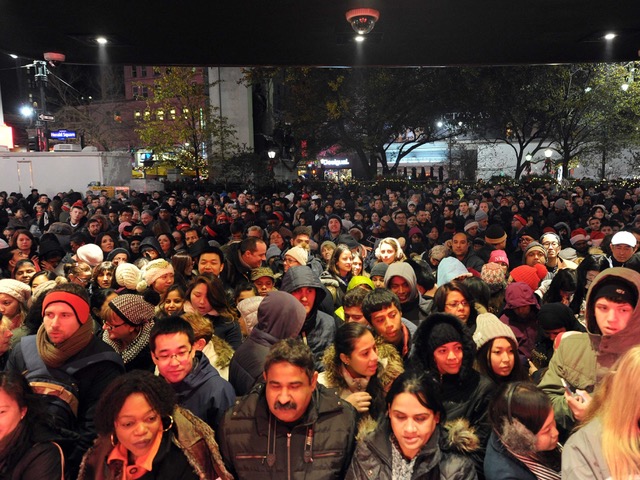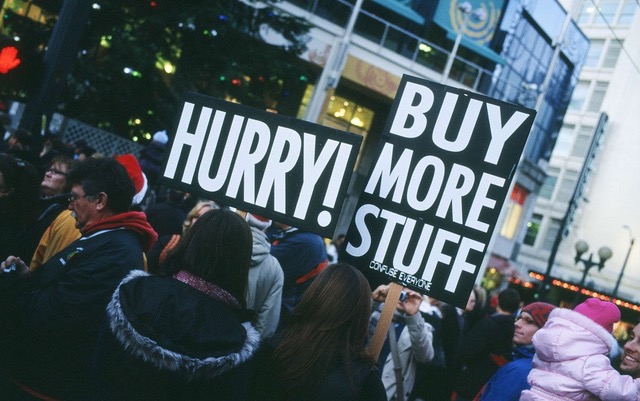
Black Friday
That “ca-ching” you hear is not a cacophony of Christmas bells, but rather the sound of credit card readers in retail stores all over the land gobbling up the hard-earned shekels of American shoppers on a tear to spend as much as they can as fast as they can. Today, you don’t even have to leave home, a keystroke or two will eat up your credit line as quickly.
The holiday spending spree is just beginning and already the results from one day, Black Friday, have gladdened the hearts (and wallets) of retail titans everywhere. Even on Thanksgiving Day (Black Friday has expanded backwards in the last few years and shopping mania now starts Thanksgiving afternoon) shoppers outspent their 2017 total by $3.7 billion an astounding 28% increase. Retail executives are on cloud nine as analysts are predicting a “very healthy” 5% to 6% growth in holiday retail sales. Egged on by the corporate media, 90% owned by six robber barons, the unwary consumer is led to believe that life in the U.S. is a bowl of cherries —a healthy economy, high consumer confidence and rising wages. So spend away, the media prods, not a thing to worry about. Could that be true? Could we really be living in the land of milk and honey and not realize it?

Media fairy tales aside, the facts tell a different story. According to the Federal Reserve, 40% of adult Americans would struggle to pay an unexpected expense of $400. Let’s hope they’re not the ones queuing up at malls all over the U.S. credit cards in hand. As for that rising wage hokum, here’s a headline from of all places, The Washington Post, owned by corporate mogul, Amazon’s Jeff Bezos — “In U.S., wage growth is being wiped out entirely by inflation.” (August, 2018).
So wages aren’t really rising, the U.S. economy is still healthy, right? Judge for yourself. With the Federal Reserve on a tear to raise interest rates (they have promised four more rate increases in 2019), consumers can expect higher interest rates on home and car purchases, student loan repayments, and credit card balances. To stir the pot a little more, the R (recession) word is making the rounds. Those in the know point to China’s slowing growth, the rapidly declining health of most European economies and in the U.S. stagnating wages and the long-term impact of Trump’s $1.5 trillion tax cuts aimed at business and the rich.
Despite the gloomy prognostications for middle and working class Americans, something in our DNA keeps us bullish on the economy. In the American bible, consuming has replaced producing as a value right up there with mother and apple pie. it doesn’t hurt that the media plays along, assuring U.S. consumers that they’ve never had it so good. Of course, they leave out a lot like the rise of consumer indebtedness. According to the Federal Reserve, In 2017, U.S. credit card debt hit a record high of just over $1 trillion ($1.021 trillion). This year’s holiday spending spree will increase that total exponentially.
As the holiday season ends and the bills come flying in, many Americans will be on the horns of a dilemma. How to pay back the over $1 trillion that most analysts expect will be spent this year. With interest rates rising, the unpaid balances on credit cards are going to be the gifts that keep on giving for behemoth credit card companies. Here are some statistics that should (but probably won’t) make consumers think twice and hopefully three or four times before pulling out a credit card for their holiday “essentials.” Many shoppers come into the 2018 excess spending season already carrying a mountain of debt. In fact, 43% of Americans start off with credit card balances they have been carrying for two or more years. For households with credit card debt, the average amount of debt is a whopping $16,883. These debtors, in the same fashion as indentured servants, pay the credit card companies an average of $1,300 annually in interest on their unpaid debt.

Surely these facts of life will scare even the most ardent shopper straight. Actually no. According to a Harris poll conducted in November, shoppers were practically unanimous on one point – bolstered by phony media assurances that buying was akin to a national priority, shoppers expected to spend an average of $776 on their holiday purchases, an increase of 18% over the $660 they plunked down in 2017. And if you’re the National Retail Federation, the mouthpiece (aka lobby), of the biggest and wealthiest retail companies, you have another reason to revel in the excesses of a deluded public. Beyond gift buying, such holiday accompaniments as food and holiday attire bring the total holiday price tag to —you ready for it — $1,007 per consumer (4.1% increase over 2017).
Credit card debt hits the hardest on those who make the least. And that’s a boat many American wage earners occupy. Half of U.S. jobs pay less than $18 per hour. That’s not all. In the richest country in the world, in 2015, one-half of U.S. wage-earners brought home less than $30,000 a year (according to the Social Security Administration). An exceptional development for an exceptionally unequal nation. With a massive and expensive corporate public relations effort, helped by media optimism over “record low unemployment,” a “booming economy,” and “increased consumer confidence,” Americans have willingly turned a blind eye to the negative economic indicators that Rachel Maddow and Lawrence O’Donnell don’t talk about. How about an unemployment rate that is really 7.4% minus statistical tricks like removing from the equation “discouraged” workers, counting as employed workers who may have worked as little as one day in the entire month and other tricks that skew the unemployment rate down to where politicians can brag about it.
How about the rise of the stock market which in media parlance signifies a “booming economy? Booming for whom? The top 10% of U.S. households own 84% of all stocks. The Dow Jones Index may have increased 32% since 2016, but the average American worker has seen virtually no uptick in personal wealth. On the other hand, stock market performance is a double-edged sword for most Americans. Little benefit when all systems are go, but when the stock market falls (the polite term is a correction) Jane and John Q. Public will be on the firing line. To appease shareholder wrath as the juicy returns stop, most corporate honchos will cut staff (costing an untold loss of jobs) to reduce costs and save their own jobs and bonuses.
Back in 1925, President Calvin Coolidge declared “The chief business of the American people is business.” For the next nine decades, American oligarchs have taken up the cry convincing
consumers that spending is the American way. Here’s President George W. Bush, seventy-six years later, after 9/11 “Get down to Disney World in Florida. Take your families and enjoy life, the way we want it to be enjoyed.” In other words, it’s okay to go into debt to finance a vacation, a new iPhone or any other gadgets on your wish list. In fact, say the oligarchs, it would be un-American not to indulge. Not a secret anymore, America’s love affair with the shopping cart has become a fact of life as the book Beyond Our Means, Why America Spends While the Rest of the World Saves demonstrates.
It’s time to see debt for what it really is — a massive transfer of wealth from the 90% to the 10%. For 43% of Americans with revolving credit card debt (carrying balance on their credit cards and paying interest monthly), for 44 million Americans (overwhelmingly recent college graduates) who owe $1.5 trillion in student loans, for the twenty-five percent of American who struggle to pay their medical bills and for all Americans in the bottom 90% of the wealth curve who are up to their eyeballs in $13.15 trillion worth of debt, we at Suspicious Angels say now is the time to get off the debt train (the gravy train for oligarchs) and stop enriching those who have more than enough already. How about an early New Year’s resolution — let’s stop giving our hard-earned money to the people who deserve it least.
946 total views, 1 views today
